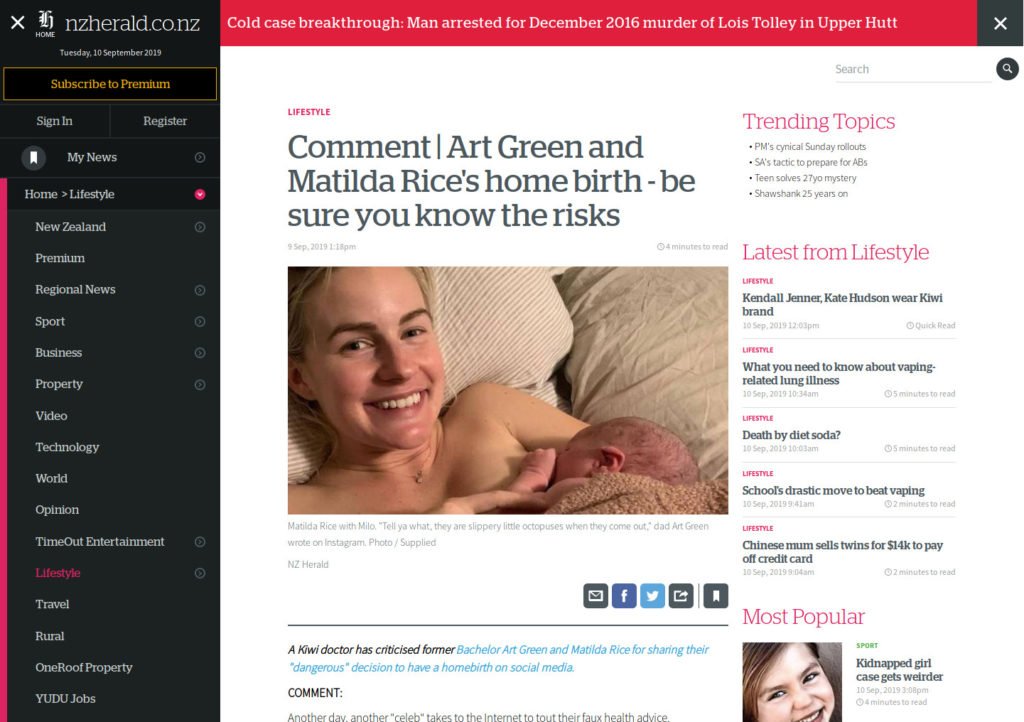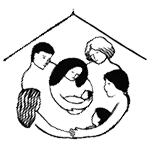On the 9th of September the New Zealand Herald published an article titled “Comment: Art Green and Matilda Rice’s social media post irresponsible – home births risky” by an ‘anonymous Kiwi doctor’ . The headline was changed to ‘Comment | Art Green and Matilda Rice’s home birth – be sure you know the risks’ and at least as of 11th Sept., the article has been removed entirely. The article can still be viewed here: Internet Archive [1]

Following is the official response of Auckland HomeBirth Community.
11 September 2019
To the ‘Anonymous qualified doctor based in the South Island’ and the New Zealand Herald
Re: the article published “Comment: Art Green and Matilda Rice’s social media post irresponsible – home births risky (original headline).
Your article does not reflect the published evidence on the safety of birthing at home. There is an increasing wealth of evidence and knowledge on the safety of planned home birth. Published studies show that birthing at home is at least as safe as birthing in a birth unit or hospital for normal, healthy pregnancies attended by skilled midwives. We have a list of such papers here: Homebirth Papers
One of the most recent systematic review and meta-analysis (Scarf et al 2018) concluded:
“High-quality evidence about low-risk pregnancies indicates that place of birth had no statistically significant impact on infant mortality. The lower odds of maternal morbidity and obstetric intervention support the expansion of birth centre and home birth options for women with low-risk pregnancies.”[2]
Home birth is publicly funded and promoted by the Ministry of Health (MoH). The MoH’s website page ‘Where to give birth’ states:
“You can choose where you have your baby – at home, in a birthing centre or small maternity unit, or in hospital.
Women who give birth at home or in a birthing centre or small maternity unit are more likely to have a normal birth than those who give birth in hospital.
You should discuss the place of birth with your midwife or specialist doctor as part of your planning in early pregnancy. Unless you have complications all of these choices are safe.”[3]
Additionally under subsection “Giving birth at home” (listed as the first option), the MoH states:
“Home birth is a safe choice for many women. Women who have home births use less pain relief and have fewer caesarean sections and forceps than women who give birth in hospital. If you want to know more about this choice talk to your midwife or doctor. “[4]
The New Zealand College of Midwives Collaborative Statement on Home Birth and Primary Birth Units states:
“Women who are experiencing normal pregnancies should be offered the option and encouraged to give birth in primary maternity facilities or at home. The evidence clearly demonstrates that women who receive effective antenatal care and are assessed to be at low risk for complications, will give birth to healthy babies and need fewer interventions if they are supported to give birth in a primary maternity unit or at home.”[5]
It is woefully misleading to say, “in the US alone, in the last century maternal mortality rate has declined from a whopping 900 per 100,000 births, to below 15” without also stating that the US has one of the highest maternal mortality rates in the developed world (26.4 in 2015[6]) and still rising, high rates of obstetric interventions (including increasing rates of caesarean surgery) and spends more on maternity care than any other country in the world. Clearly, the huge amounts of money the US is spending and the high rate of interventions performed on pregnant people is not improving maternal and neonatal health or mortality rates.
Nor do US statistics have much bearing on the New Zealand maternity system. A century ago, even during the height of iatrogenic puerperal sepsis, the New Zealand maternal mortality ratio (MMR) was lower than your quoted US rate (“900”) at 648 per 100,000 births.[7]. In fact, the last time New Zealand had an MMR as high as 15 was 1996.[8] At 2016, the New Zealand MMR was 9.4 per 100,000.[9] Sadly, suicide is still the leading cause of maternal death in New Zealand. It is our belief that you and the NZ Herald would be better spending your time addressing maternal mental health than disparaging the safe aspects of our maternity system and individual womens’ choices.
Overwhelmingly, articles and media related to birth gives the impression that birth is inherently dangerous, incredibly risky, terrifying, painful and something to be endured and survived. Both the experiences of our home birth community (what you might flippantly call ‘anecdotal’) and that of qualitiative studies show that birth at home can be satisfying and yes, even enjoyable![10][11] Additionally, positive narrative has an impact on the perceptions of birth. As Ina May Gaskin says in her book Ina May’s guide to Childbirth, “Stories teach us in a way we can remember. They teach us that each woman responds to birth in her unique way and how very wide-ranging that way can be”.[12] Auckland HomeBirth Community feels strongly that positive birth stories are essential to hear and read and that pregnant people find it empowering and reassuring to read such stories and see positive images during pregnancy in the lead up to their own birth. Fear and fear-mongering is not conducive to physiologic birth or a positive birth experience. As Dencker et al (2019) concluded:
“Stress, anxiety, depression and lack of social support are associated with fear during pregnancy. Need for psychiatric care and presence of traumatic stress symptoms are reported outcomes together with prolonged labour, longer labours, use of epidural and obstetric complications. Nulliparous and parous women have similar levels of fear but for different reasons. Since the strongest predictor for fear in parous women is a previous negative birth experience or operative birth, we suggest it is important to distinguish between fear of childbirth and fear after birth. Findings demonstrate the need for creating woman-centred birthing environments where women can feel free and secure with low risk of negative or traumatic birth experiences and consequent fear.”[13]
In New Zealand a person’s right to informed choice is protected by law under the Health and Disability Commissioner (Code of Health and Disability Services Consumers’ Rights) Regulations 1996 (Health and Disability Commissioner Act 1994).[14] We find it disturbing that you, as a New Zealand doctor, not only do not seem to understand the basic rights around informed choices (“The right to be fully informed.“) and consent (“The right to make an informed choice and give informed consent.”) but you publish what amounts to a misogynistic, condescending rant (“The right to be treated with respect.”) about a particular woman’s informed choice on place of birth.
Celebrities are human beings with intrinsic rights no more or less than any other person. And just like other people they want to share the birth of their baby on social media. They are no more or less ‘allowed’ to share their birth experience than anyone else.
Anonymous Kiwi doctor, you commented, “what Art and Matilda choose to do with their own #baby [sic] is nobody’s business but their own. Wanna have a homebirth? Go ahead.” On that we agree – it is their informed choice and their right to do so.
FURTHER READING
- New Zealand College of Midwives – College response to the NZ Herald article re: homebirth
https://www.midwife.org.nz/news/college-response-to-the-nz-herald-article-re-homebirth/ | Archive - The Spinoff – Art and Matilda’s home birth was safe and critics need to back off by Emily Writes
https://thespinoff.co.nz/parenting/10-09-2019/art-and-matildas-home-birth-was-safe-and-critics-need-to-back-off/ | Archive - Home Birth Bound: Mending the broken weave by Maggie Banks
2000. ISBN: 0-473-06993-8 - For Her Own Good: Two Centuries of the Experts’ Advice to Women
by Barbara Ehrenreich and Deirdre English
2005. ISBN-13: 978-1400078004
References


Wow. Beautifully expressed and a fabulous response.